

E-Newsletter
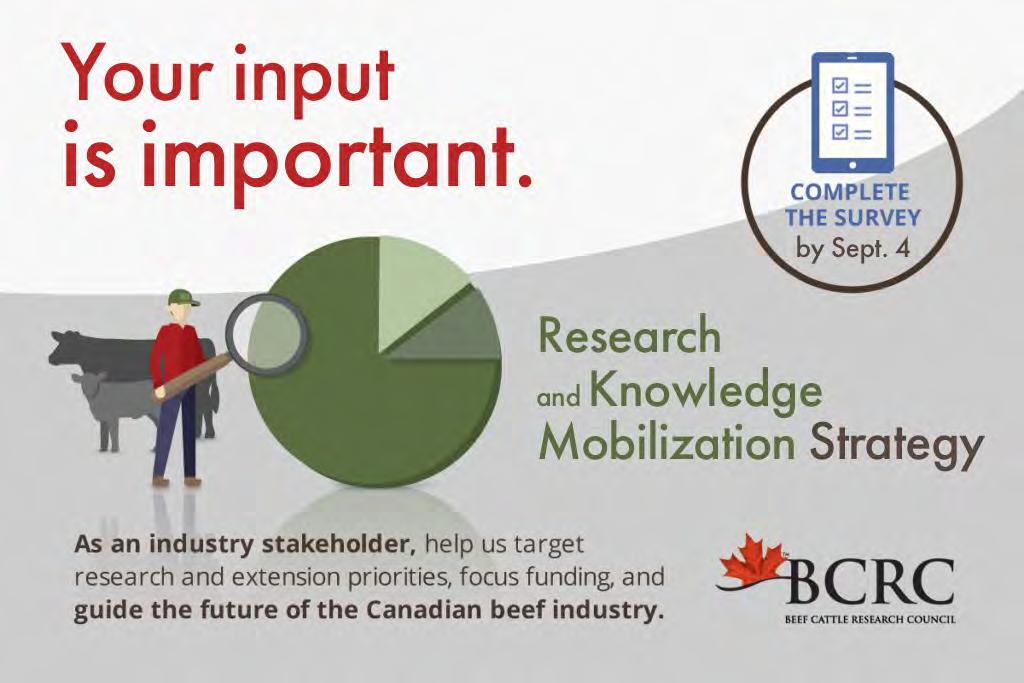
The Beef Cattle Research Council is currently developing the renewed Five-year Canadian Beef Cattle Research and Knowledge Mobilization Strategy.
The strategy provides a framework for achieving national coordination of beef research priorities, funding and technology transfer efforts.
It identifies key research and technology transfer priorities to maximize benefits obtained from investments in beef research and extension. It directly supports the industry’s 10-year goals and improved productivity in a sustainable manner with targeted outcomes.
One part of this process is an online survey to gather the priorities and opinions of Canadian cattle producers and people involved in the beef industry. Scan the QR code or click the graphic for the survey link.


June 6, 2025

Reminder
MBP has six $1,000 scholarships for MBP members or their children attending a university, college, other post-secondary institution or pursuing trades training. Preference will be given to those students pursuing a field of study related to agriculture or to those acquiring a skilled trade or pursuing a career that would be beneficial to the rural economy. See page 7 for the link to the application that is due on June 20!
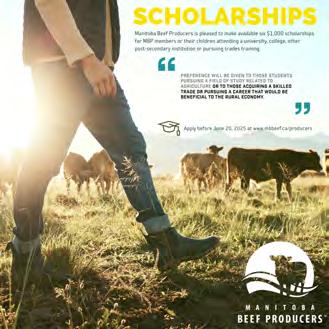





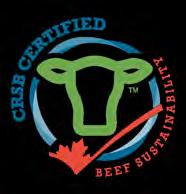
Farm Credit Canada opens 2025 Sustainability Incentive Program
Doubling eligible maximum payment to $4,000
Monday, June 2, 2025, Calgary, AB. - The Canadian Roundtable for Sustainable Beef (CRSB) is pleased to announce that Farm Credit Canada (FCC)’s 2025 Sustainability Incentive opens today for applications for the 2025 program year. To further recognize and support farmers and ranchers in their sustainability journeys, FCC has doubled the eligible maximum annual incentive payment per operation to $4,000 for all program partners of FCC’s Sustainability Incentive.
Incentive payments are calculated as a portion of FCC lending, up to a maximum of $4,000 in one year. Existing participants can reapply annually throughout the life of the program, and FCC welcomes new applications any time.
Eligibility Requirements for the CRSB Certified Sustainability Incentive:
• Must be CRSB Certified through a CRSB-approved Certification Body (Verified Beef Production Plus [VBP+], Ontario Corn Fed Beef Quality Assurance Program or Where Food Comes From)
• Must be an FCC customer in good standing with a balance owing on eligible, existing FCC lending
The application is quick and easy. To verify eligibility, FCC simply requires contact information, FCC customer number, a copy of the active operation’s CRSB Certification and name of Certification Body that provided the certification.
FCC now has a number of Sustainability Incentive Programs - if you participate in more than one program for which FCC has an incentive, you may be eligible to qualify for more than one incentive payment.
“It’s great to see FCC is increasing their incentive payment, which is further recognition for producers who are adopting sustainable practices that contribute to a resilient food system in Canada. As a beef producer myself, this increase in the total eligible incentive payment adds even more value to the CRSB certification program & now’s a great time to consider certification! I hope to see others come forward to support Canada’s beef producers’ commitment to sustainability.”
Don Badour -Chair, Certified Sustainable Beef Framework Canada
Learn more about FCC’s Sustainability Incentive.
Providing assurances for the production, processing and sourcing of beef through certified supply chains in Canada.
Statistics Canada’s Farm Product Price Index, March 2025
(Source: Statistics Canada’s The Daily for June 5, 2025) The Farm Product Price Index (FPPI) rose 4.0% on a year-over-year basis in March, as the gain in the total livestock and animal products index outweighed the loss in the total crops index. This marked the FPPI's fifth consecutive month of year-over-year increase.
The total livestock and animal products index rises on strong demand for cattle and a shrinking cattle herd
The total livestock and animal products index was up 11.1% in March compared with the same month one year earlier. The increase was primarily attributable to gains in the cattle and calves index and the hogs index.
The cattle and calves index rose 17.4% in March compared with March 2024. The strong demand for cattle and a shrinking cattle herd contributed to the increase in March 2025. Year over year, the quantity of cattle exported for immediate slaughter was up 16.3%, and the value of cattle exported for immediate slaughter increased 36.5% in March. The inventory of Canadian cattle as of January 1, 2025, was the lowest level since 1989.
On a year-over-year basis, the indexes for hogs (+13.4%) and dairy (+6.0%) were up in March 2025, while the indexes for eggs (-1.2%) and poultry (-1.1%) were down.
Decline in the total crops index driven by lower prices for most crops
In March, the total crops index decreased 1.6% compared with March 2024, marking the third consecutive year-over-year decline in March. The drop in the crops index in March 2025 was driven by lower prices for most crops. The specialty crops index fell 10.0% in March compared with the same month the previous year, mainly due to lower prices for chickpeas (-33.1%) and dry peas (-15.3%). A 100% import tariff on peas imposed by China put downward pressure on the price of Canadian dry peas.

The grains index (-5.3%) recorded a third consecutive year-over-year decline in March. Prices for all major grains (except corn) were weaker in March compared with the same month one year earlier, with rye (-24.7%) and durum (-20.2%) leading the price decreases.
In March, the oilseeds index shrank 0.5% from March 2024. The decline in March 2025 was primarily due to lower prices for soybeans (-11.4%), as increased domestic supply put downward pressure on prices.
Increases in the price indexes for fresh vegetables (+2.8%), fresh fruits (+1.6%) and fresh potatoes (+1.5%) mitigated the year-overyear decline in the total crops index in March.
Province of Manitoba Fire Bulletin #25
(Select Excerpts from June 5, 2025 Province of Manitoba News Release) The Manitoba Wildfire Service Manitoba continues under a provincewide state of emergency, as the majority of the province continues under very high fire danger, with human activity continuing to significantly contribute to Manitoba’s current wildfire situation.
Manitobans are urged to carefully follow all fire and travel restrictions. Level 3 fire and travel restrictions are in place across much of the province including all provincial parks and all burn permit areas (areas 1 to 22). Backcountry travel is prohibited without a permit. To request a travel permit, email: BackcountryTravel@gov.mb.ca or call (204) 345-1489.
A full burn ban is in place. Campfires are prohibited even in approved pits. Full details on fire and travel restrictions for provincial parks and burn permit areas, along with municipal burn bans can be found at www.manitoba.ca/wildfire/#travel_restrictions.
Check the air quality health index to see how the wildfire smoke could be affecting you and your community, even if you’re located far away - click here.
• Burntwood Hotel, 146 Selkirk Ave., Thompson – open 10:30 a.m. to 6:30 p.m. daily
Evacuees are encouraged to register with the Canadian Red Cross as soon as possible. Registration can be done online at www.redcross.ca/2025manitobawildfires or by calling 1-800-863-6582 (toll-free) between 8 a.m. and 10 p.m. CST. If it is necessary for the Canadian Red Cross to contact evacuees, the contact information provided upon registration will be used. Providing an email address allows the Red Cross to communicate information more quickly to evacuees.

Manitoba Parks advises that trails and water routes in all provincial parks are closed. Several provincial parks in the eastern and northern regions are closed to all park users. Check www.manitobaparks.com for details.
Congregate shelters are located throughout the province. Provincial emergency social services (ESS) and the Canadian Red Cross are working with partners to ensure people evacuating from northern Manitoba can find shelter. Evacuees who do not have a place to stay are asked to proceed to the nearest reception centre:
• Billy Mosienko Arena. 709 Keewatin St., Winnipeg – open 24-7
• Victoria Inn, 3550 Victoria Ave., Brandon –open 10:30 a.m. to 6:30 p.m. daily
As of June 5, the Canadian Red Cross has registered approximately 18,000 people from over 7,100 households evacuated due to the wildfires in Manitoba. This includes people from over 3,300 households on behalf of Indigenous Services Canada, and over 3,600 households on behalf of the Province of Manitoba.
The governments of Canada and Manitoba are matching donations made to the Canadian Red Cross 2025 Manitoba Wildfire Appeal to support those affected by the wildfires. Every $1 donated will become $3 to support the families and individuals most impacted by wildfires. Donation matching will be open for 30 days, retroactive to May 28. For more information, visit www.redcross.ca.
Donations and public support should be coordinated through official channels, as the evacuation centres are not set up to receive them. The Assembly of Manitoba Chiefs has set up a collection hub for donation items at the RBC Convention Centre, 375 York Ave., Winnipeg. The Southern Chiefs Organization and the Manitoba
Province of Manitoba Fire Bulletin #25
Métis Federation are also co-ordinating collection drives, please visit the organizations’ websites and social media channels for more information.
Information about health supports for evacuees, including mental health resources and Indigenous wellbeing supports, is available through Shared Health at https://sharedhealthmb.ca/news/wildfireupdates/. For general health care information and for services such as refilling a prescription, or for information about a loved one who may have been relocated from their personal care home or hospital, call Health Links-Info Santé at 204-7888200 or 1-888-315-9257 (toll-free).
Evacuees in congregate shelters with health concerns can speak with onsite health care providers who can help with medical concerns, new prescriptions and renewals, as well as mental health and addictions concerns. Evacuees are encouraged to visit a health information table at the site for additional support.
In eastern Manitoba, some residents are allowed to return home but a significant wildfire threat remains. The province advises all returning residents must be prepared to evacuate with little notice and should prepare an emergency go kit. More information on emergency preparedness, including what to include in an emergency go kit, is available at www.gov.mb.ca/emo/guide/individuals
Evacuees who need help connecting with supports while they are evacuated can contact Manitoba 211 for assistance by calling 211 from anywhere in Manitoba or emailing 211mb@findhelp.ca. For more information, visit https://mb.211.ca/get-helpnow/
Smoke and fires are impacting road conditions as well, check MB511 at www.manitoba511.ca for the latest road conditions and closures.
The Manitoba government’s provincial state of emergency, under the Emergency Measures Act, is in effect until June 26.
Many municipalities have proactively implemented burning restrictions this spring, so check with the local municipal office or view the interactive burning restrictions map at www.manitoba.ca/wildfire/burn_conditions.html for more information. No burning permits will be issued for areas within or bordering any municipality where burning restrictions are already in place. The current provincewide ban is for provincial lands and does not include federal land or municipalities. Manitoba municipalities are responsible for the implementation and maintenance of their local burning restrictions and are asked to contact the Office of the Fire Commissioner from 8:30 a.m. to 4:30 p.m. Monday through Friday at firecomm@gov.mb.ca when implementing or changing the status of its municipal burning restrictions. Visit the Municipal Burning Restrictions Map at www.gov.mb.ca/wildfire/burn_conditions.html f or more information.
For further information on the Manitoba Wildfire Service, situation updates, restrictions and other important wildfire links, go to www.gov.mb.ca/wildfire or follow the Manitoba government on X (formerly Twitter) at https://twitter.com/mbgov
To report a wildfire, call 911 or the TIP line toll-free at 1-800-782-0076.
Manitoba Government Launches Wildfire and Public Safety Information Portal
(June 5, 2025 Province of Manitoba News Release)
The Manitoba government has launched MB Ready, a centralized portal designed to keep Manitobans informed during emergencies, Transportation and Infrastructure Minister Lisa Naylor, minister responsible for the Emergency Management Organization (EMO), announced.
“In times of crisis, timely and accurate information makes navigating uncertainty a little bit easier,” said Naylor. “Our government is proud to launch this tool that will ensure every Manitoban, no matter where they live, can stay informed and connected during emergencies.”
MB Ready, managed by the EMO, will provide timely information on events as they occur and supports available to impacted Manitobans.
The site will continue to evolve in the coming weeks and months, with new features and updates aimed at improving accessibility and responsiveness.
EMO co-ordinates and manages the response to emergencies and disasters on behalf of the Manitoba government, including:
• overseeing emergency preparedness;
• managing, directing, and co-ordinating the response of all Manitoba government departments to a major emergency or disaster;
• supporting recovery efforts following an emergency or disaster; and
• implementing mitigation strategies to reduce the impacts over time.
For more information on the portal, visit https://mbready.manitoba.ca/.

Applications due in two weeks

Wildfire Information For Producers

Due to the dry conditions, parts of Manitoba have been affected by wildfires. The following is information that may be useful to producers affected by these conditions, or those preparing for the possibility of a wildfire.
For current information re: the wildfire situation, including fire maps, fire and travel restrictions, etc., go to:
https://www.gov.mb.ca/nrnd/wildfire_program/
To report a wildfire call:1-800-782-0076 (tollfree)
A reminder about individual responsibilities during an emergency from the provincial Emergency Management Organization (EMO):
Step 1: – Producers/Individuals are the first point of responsibility to deal with their own emergency situation.
Step 2: – If individuals cannot provide appropriate response to their emergency situation, their local municipality is the first point of contact for emergency-related information and assistance.
Step 3: – If the local municipality cannot handle the situation, that municipality will contact the Emergency Management Organization (EMO) for assistance. If EMO requires Manitoba Agriculture’s assistance, they will assign an issue to our emergency coordinator.
Producers who need to transport livestock to an alternate area are encouraged to book a transport company immediately to ensure service.
Protecting livestock and crops
Source: Manitoba Wildfire Evacuation Guidelines
• Owners should have an evacuation plan for livestock threatened by fire. If animals can’t be moved to a safe area on your property, make and confirm transportation and feeding arrangements in advance. Obtain insurance coverage for all farm resources at risk from fire, including crops and livestock.
• The risk to farm animals can be reduced by preparing and maintaining fuelreduced areas. Livestock can be moved and held there during a fire. Use a plowed or heavily grazed field with a minimum of grass or stubble. If possible, this field should be shaded and located well away from any forested areas. Water should be available.
• Concrete or metal buildings located away from forest vegetation are another livestock shelter option.
• As a last resort, if you are unable to move livestock to a safer area, cut fences and turn the animals loose, as long as there is no danger to people or traffic.
For more information about preparing for a wildfire, go to:
https://www.gov.mb.ca/nrnd/pubs/fire/wildfire _evacuation.pdf
Manitoba Agriculture also has information about evacuating livestock: https://www.manitoba.ca/agriculture/animalhealth-and-welfare/emergency-
Wildfire Information For Producers
preparedness/caring-for-livestock-duringevacuation.html
Manitoba Emergency Management Organization guide for individuals facing an emergency:
https://www.gov.mb.ca/emo/guide/individuals/ index.html
Animal Health Canada resources re: emergency preparedness:
https://animalhealth.ca/ https://animalhealth.ca/otheremergencies/fires/
Mental health supports are available through entities such as:
https://supportline.ca/farm-support-services/
https://manitobafarmerwellness.ca/


Governments of Canada and Manitoba match Red Cross donations to help those impacted by wildfires
(June 4, 2025 Public Safety Canada News Release)
The Governments of Canada and Manitoba announced that they will both match every dollar donated to the Canadian Red Cross 2025 Manitoba Wildfires Appeal to support wildfire disaster relief and recovery efforts across Manitoba.
Donation matching will be open for 30 days, retroactive to when each appeal first opened on May 28.
Through this initiative, the provincial government will match donations up to $15 million.
The funds raised will be used to assist those impacted in Manitoba with immediate relief, including financial assistance, support to evacuees and the communities hosting them, as a result of the wildfires in Manitoba.
Thousands of Manitobans have been displaced as wildfires continue to threaten communities across the province. In response, the Canadian Red Cross is working closely with Indigenous leadership and all levels of government to provide emergency accommodations, personal services, and critical information to people who have been forced from their homes.
The Governments of Canada and Manitoba are committed to continue doing everything they can to support all those affected.
Canadians wishing to make a financial donation to help those impacted by wildfires in Manitoba or Saskatchewan can do so online at www.redcross.ca or by calling 1-800-4181111.
Quotes
"I would like to express my heartfelt support for the people and the communities that are affected by wildfires across the country, including thousands of Canadians who have evacuated their homes. As wildfires continue to impact communities across the provinces of Manitoba and Saskatchewan, we are committed to working closely with the provincial governments, Indigenous leadership, and the Canadian Red Cross to ensure a coordinated and compassionate response. By matching donations to the Red Cross, we are encouraging the people of Canada to come together in support of those affected and to help communities recover and rebuild with strength and resilience."
- The Honourable Eleanor Olszewski, Minister of Emergency Management and Community Resilience and Minister responsible for Prairies Economic Development Canada
"Since the start of the evacuation process, the people of Manitoba have stepped up and shown incredible kindness and empathy toward their fellow citizens facing hardship during a crisis. The provincial government is proud to reflect those values and, on their behalf, we have humbly stood with the federal government and the Canadian Red Cross to support evacuees and their families from the moment they begin to navigate the challenges of staying secure and healthy while away from their communities until they can safely return home."
- The Honourable Lisa Naylor, Minister of Transportation and Infrastructure
"This has been a devastating beginning to wildfire season in Canada and our thoughts are with those impacted by the fires. The Canadian
Governments of Canada and Manitoba match Red Cross donations to help those impacted by wildfires
Red Cross is grateful for the generosity of people living in Canada, and to the Government of Canada for their support of people impacted by wildfires in Manitoba and Saskatchewan. The Red Cross is committed to providing support to people in the immediate days of the response, as well as for recovery."
- Conrad Sauvé, President and CEO, Canadian Red Cross
Quick facts
• Donations to the 2025 Manitoba Wildfires Appeal can be made online at www.redcross.ca or by phone at 1-800418-1111.
• The Wildfire Information | Manitoba.ca web page has up-to-date evacuation information. Manitobans seeking information or supports can call the Manitoba government call centre at 204945-4772.
• Government of Canada information and resources: Wildfires
• FireSmart Canada
Reminder: Deadline to Apply for AgriStability Has Been Extended to July 31st This Year
The Manitoba government, in co-operation with the government of Canada, has extended the enrollment deadline for the 2025 AgriStability program by three months in response to tariffs in the agriculture sector and to allow producers additional time to enroll in the program as they manage the impact of current market disruptions.
AgriStability is a business risk-management program under the Sustainable Canadian Agricultural Partnership (S-CAP) that helps famers manage income risk by providing
financial assistance when their farm business experiences a large margin decline, noted the minister. The deadline will be extended from April 30 to July 31 of this year.
For more information about AgriStability, go to the following websites:
https://agriculture.canada.ca/en/programs/agri stability
https://www.gov.mb.ca/agriculture/funding/agr i-stability.html
Premier Wab Kinew Announces New Trade MOU
With B.C., Fair Trade Agreements in Place by Canada Day
(June 6, 2025 Province of Manitoba News Release)
The Manitoba government will sign a new memorandum of understanding with British Columbia to advance free trade between the two provinces and cabinet will pass regulations by July 1 to ensure mutual recognition of other provinces by Canada Day, Premier Wab Kinew announced today at the MBiz Breakfast Series hosted by the Manitoba Chambers of Commerce.
“Fair trade in Canada is something the business community has been advocating for a long time,” said Kinew. “Manitoba is moving quickly to knock down the barriers that exist so we can create more wealth, jobs and opportunities here in Manitoba and build a more resilient and sovereign Canadian economy.”
With the Fair Trade in Canada Act, the legal framework is in place to establish reciprocal jurisdictions. The next step is for cabinet to pass
mutual recognition rules for goods and services that meet comparable standards with those jurisdictions. This will remove internal trade barriers to enhance prosperity in Manitoba and Canada, which benefits both workers and businesses in Manitoba by making it easier to sell products and services across Canada, noted the premier.
Kinew also noted in the face of challenges like wildfires and new U.S. tariffs on steel, Manitoba’s economy remains strong with a reaffirmed A+ credit rating from S&P Global. Kinew highlighted consultations with the business community on the government’s Economic Development Strategy and new Innovation and Productivity Task Force chaired by Jim Balsillie as engines that will boost productivity, help the province compete in the knowledge economy, generate more jobs and improve quality of life for all Manitobans.


Manitoba Government Passes Groundbreaking Interprovincial Trade Bill with All-Party Support
(June 2, 2025 Province of Manitoba News Release)
The Manitoba government is strengthening the economy and protecting Manitobans from tariffs with the passage of Bill 47, the Fair Trade in Canada (Internal Trade Mutual Recognition) Act, and amendments to the Commemoration of Days, Weeks and Months Act (Buy Manitoba, Buy Canadian Day), Business, Mining, Trade and Job Creation Minister Jamie Moses announced.
“Everyone listened to the business community and worked across party lines because we know how important this bill is,” said Moses. “We all agree that this is a win for Manitoba and Canada. This bill puts Manitoba businesses and workers first by making it easier to sell products and services across Canada.”

The bill passed today with the support of both government and opposition members – a rare, but welcome, show of unity for Manitoba’s economic future, noted Moses.
Bill 47 removes trade barriers for goods and services between Manitoba and other jurisdictions in Canada. The elimination of interprovincial trade barriers has been called for by a number of prominent Manitoba business organizations, including the Manitoba Chambers of Commerce, Winnipeg Chamber of Commerce and the Business Council of Manitoba, added the minister.
"This is another step for Manitoba and Canada to freer internal trade. While more work needs to be done, we were pleased to work cooperatively to ensure the benefits to Manitoba families and businesses are realized quickly,” said Lauren Stone, opposition finance critic. “Our Progressive Conservative team fully supports removing any remaining barriers to interprovincial trade and labour mobility and certification within Canada. We have ensured the expedited passing of Bill 47, the Fair Trade in Canada Act, as another step towards achieving free trade within Canada.”
The passing of Bill 47 aligns more broadly with the federal government’s goal of free trade across the country by Canada Day, July 1. Additionally, internal trade is expected to be a key point of discussion for the first ministers (FMM) meeting today.
“That we are able to pass this bill in time for the FMM positions us as a leader among provinces in terms of internal trade,” said government house leader Nahanni Fontaine. “This signals that we can get great things done for Manitobans by working together.”
Bill 47 has received royal assent June 2 after being introduced earlier in May.
CAHRC and University of Guelph Partner to Expand HR Training for Canada’s Agriculture Sector
(June 5, 2025 CAHC News Release, Ottawa, ON) In a move to strengthen workforce development in agriculture, the Canadian Agricultural Human Resource Council (CAHRC) has partnered with the University of Guelph’s School of Continuing Studies (SCS) to deliver practical, industry-informed HR training tailored specifically to farm and rural business operations.
Through this collaboration, the University’s new Certificate in People Management will include a tailored elective stream, HR for Agriculture and Rural Enterprises, co-developed with CAHRC to reflect the unique HR realities of farm operations and rural businesses.
This comprehensive program is designed for farm owners, managers, rural business operators, and team leaders who often manage teams without the support of dedicated HR professionals. Learners will gain essential HR knowledge for their business through a flexible, online asynchronous format via the University of Guelph’s Brightspace platform.
“CAHRC brings a strong understanding of the agriculture industry and decades of experience in human resource management and labour market research to this partnership,” said Jennifer Wright, Executive Director of CAHRC. “By combining our close connection to primary producers and agribusinesses with the University of Guelph’s academic excellence and robust delivery infrastructure, we’re building a meaningful collaboration to deliver practical, high-quality HR training tailored to the needs of Canada’s agriculture sector.
“We are thrilled to partner with the Canadian Agricultural Human Resource Council (CAHRC) to develop innovative agricultural HR courses tailored specifically for agribusiness professionals,” says Dianne Tyers, AVP, School of Continuing Studies. “This collaboration allows us to combine academic
expertise with real-world insights, equipping professionals with practical, industry-relevant HR knowledge to attract, manage, and retain the talent they need to thrive in this dynamic industry. It’s exciting to build something that directly benefits rural communities and we can’t wait to see the positive impact of this program.”
This certificate program complements CAHRC’s Ag HR Micro-credential Program, helping scale training delivery and increasing national reach. Agriculturespecific micro-credentials within the certificate will cover essential topics such as:
• Managing seasonal and temporary workers
• Navigating domestic and international labour laws
• Promoting safe, healthy farm workplaces
• Embracing cultural and language diversity in rural teams
Upon completion, learners will receive University of Guelph–branded digital badges, affirming their commitment to workforce excellence and continuous development.
CAHRC, with its unique position in the industry, brings its agricultural expertise to the program by:
• Supporting course development and content accuracy
• Ensuring alignment with real-world industry need
• Promoting the program nationally through its extensive agri-sector network
• Participating in the program advisory committee
This partnership directly supports CAHRC’s mission to deliver workforce development solutions grounded in research and industry collaboration. It also aligns with the goals of the National Workforce Strategic Plan for Agriculture and AgriFood, by improving HR knowledge, strengthening leadership in rural enterprises, and making training more accessible across regions and roles.


CYBER SECURITY RISKS AND RESOURCES:
Safeguarding Canadian agriculture and agri-food
As agricultural and agri-food businesses become more digitized and connected online, the need to safeguard against cybercrime increases. Precision agriculture, automation and smart farming technologies contribute to efficiency and productivity, but without proper safeguards, the door opens to cyber vulnerabilities that can range from disruptive to devastating effects, including paralyzing business and impacting profitability and consumer trust.
In this digital landscape, it’s critical to understand and guard against cyber risks.
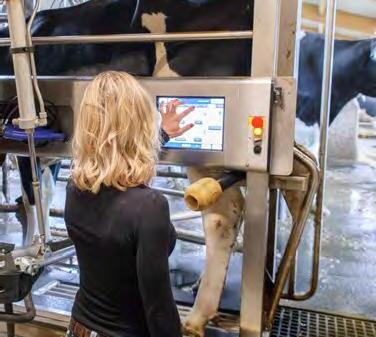
What is cyber security?
Cyber security is the practice of safeguarding computer systems, networks and data from digital disruptions. Examples of cyber incidents affecting the agriculture and agri-food industry include fraudulent texts, phishing emails that seek to gain private info and access to systems, and ransomware demands, to name just a few.
What agricultural systems are at risk?
Targets can include production, financial, customer and other data, wireless sensors, automated and robotic machinery, autonomous and semiautonomous vehicles and equipment, and heating, refrigeration, lighting and ventilation controls and systems.
Quick tips to minimize your risk
○ Have different passwords for each account, preferably 12 characters-long, including 1 upper and 1 lower case letter, and 1 special character. Change passwords frequently.
○ Enable multi-factor authentication on all your accounts, wherever possible.
○ Back up vital information regularly, including vendor and client data and information. Store backup information offline or in an external drive.
○ Don’t open unknown emails, and don’t click on links or attachments unless you’re sure of their origin and legitimacy.
Canadian Centre for Cyber Security
○ Don’t save personal or financial data on browsers if prompted and avoid auto-fill features.
○ Access more tips at agriculture.canada. ca/cyber-security-farming-business.
Get started today with these tools and resources
A go-to resource for expert advice, guidance, services and support, and to report cyber incidents
Public Safety Canada
Access the Canadian cyber security tool assessments. Select “National Security” then “Cyber Security”.
cyber.gc.ca publicsafety.gc.ca
Community Safety Knowledge Alliance
Access targeted resources to help protect your farming business.
cskacanada.ca/projects/strengtheningthe-cyber-security-capacity-of-canadasagricultural-sector


CHECKLIST FOR SMALL AND MEDIUM-SIZED ENTERPRISES
Cyber security and your farming business
You can take simple and effective steps to increase your protection from common cyber security incidents.
Secure your devices and data
I have changed the default passwords of all my devices that connect to the internet or are GPS-enabled, both on my farm and in my home.
• This includes the passwords of the routers for Wi-Fi network(s), tractors and other machinery in the field
I have a unique and strong password for each of my accounts.
I have a password policy for my employees.
• Employees are reminded to change their passwords every quarter and they cannot reuse a password.
I have multi-factor authentication (MFA) enabled on all my accounts.
• MFA adds an extra layer of security to accounts and makes it harder for threat actors to gain access.
Stay updated, stay safe
I have downloaded and installed an anti-virus software from a trusted source.
I have updated the firmware of all systems used in my business from reputable sources, to minimize the risk of a supply chain attack.
I have enabled automatic software updates so that I do not miss an important security update.
I review the list of authorized employees that can access the network and our data every 6 months, and remove permissions where needed.
I conduct a review every 6 months of the applications (apps) I have downloaded on my devices and uninstall the ones I no longer use.
• Periodically checking app permissions ensures they don’t access data that is not relevant to their function.
• Turn off the permission that allows an app to know your location when you are not using it
I back up valuable data and information on a quarterly basis and store a copy offline in a place that’s separate from my network. If a security breach happens, I will be able to access the important files I need to resume operations.
• This includes key contact information on clients, vendors, partners, and any proprietary agricultural data collected from agriculture technology devices.
For more information on how to minimize your cyber security risks, visit agriculture.canada.ca/cyber-security-farming-business For additional resources on how to stay safe online, visit getcybersafe.gc.ca

Cyber security preparedness
Plan to Detect, Respond, Recover
Detect

In today’s digital age, it’s essential to be able to quickly and effectively respond to cyber incidents. Use this guide to establish procedures and documentation that help detect, respond to and recover from cyber incidents, minimizing the impact on your farming business.
Monitor your systems and data and proactively plan for any cyber security incidents.
✓ Assign a cyber security lead to monitor your systems and data.
✓ Make sure your employees know how to report security issues or unusual activity.
✓ Make an asset inventory list, including those that are required to maintain your operations
✓ Identify key contacts, both internal and external, to notify during an incident.
✓ Maintain a list of reputable professional services that you could contact in the event of a cyber incident.
✓ Develop a communications plan to inform customers and the public if operations are affected.
✓ Run anti-virus and anti-malware software on all devices
Cyber security lead
Monitors systems and data, and is the employee point of contact. Use the space below to record names and contact info.
Cyber security lead:
Alternate contact:
Other key contacts and service providers
In an incident, the cyber security lead informs all key contacts and liaises with professional service providers. Use the space below to record names and contact info.
Communications lead:
Legal lead:
Key suppliers:
Key clients:
Investors:
Professional services providers:
Respond
Take immediate actions to contain and mitigate the impact of the attack.
✓ Disconnect all devices from the network immediately.
✓ Suspend employee access temporarily, to prevent further incidents.
✓ Seek professional cyber security services if needed.
Recover
✓ Change affected passwords and enable multi-factor authentication (MFA).
✓ Notify your financial institution if financial information was compromised.
✓ Communicate the incident to your key contacts and the public, as needed.
✓ Report the incident to local police, the Canadian AntiFraud Centre and Canadian Centre for Cyber Security.
Restore systems and data, update security measures, and learn from the incident.
✓ Restore systems and data from backups.
✓ Update all software, including your anti-virus software, firewalls and firmware.
✓ Run anti-virus and anti-malware software on all devices.
✓ Identify and address any security flaws.
✓ Patch and update any security vulnerabilities.
✓ Analyze the incident and your response, and conduct a lessons learned exercise with all key contacts.
Validate
Test and refine your cyber security preparedness.
→ Regularly review each step of your preparedness plan to ensure all systems and assets are included.
→ Conduct walk-throughs of your plan, using specific incidents, to identify any vulnerabilities.
→ Perform simulations with your team to practice responding to a cyber attack.
→ Test your backup systems to be sure of business continuity during an incident.
For more information on how to minimize your cyber security risks, visit agriculture.canada.ca/cyber-security-farming-business
For additional resources on how to stay safe online, visit getcybersafe.gc.ca


QUESTIONS TO ASK BEFORE MAKING YOUR NEXT AGTECH PURCHASE
Help protect your farming business from cyber security risks
As your farming business becomes more digitized and connected online, it’s critical to guard against cyber security risks. These questions can help guide your conversation with agriculture technology vendors so you can make informed decisions about who you are trusting to protect your business from cyber security risks and safeguard your data and operations.
Does
the vendor have a good reputation?
• How long has the vendor been in business?
• Is the vendor known to you?
Does the vendor work with other companies in your sector?
• Do they know your line of business or commodity?
• Are they expanding their reach in your sector, or are they a new entrant?
• Do they have a good reputation?
• Will the vendor provide contact information for customers you can speak to for feedback (known as reference customers)?
What steps will the vendor take if there is a data breach that impacts data they have stored about you and your business?
• Have there been previous data breaches? If so, what happened?
• Can they explain simply how your data is stored and protected?
• Do they have an emergency response plan they can share with you?
Can the vendor explain your contract in plain language?
• Can they explain the clauses in your contract in a way that’s easy to understand?
• Can they tell you where your information is stored, who has access to it, and how it is protected?
This isn’t a full list of questions, but it’s a good starting point for talking with a new vendor.
For more information on how to minimize your cyber security risks, visit agriculture.canada.ca/cyber-security-farming-business
For additional resources on how to stay safe online, visit getcybersafe.gc.ca
CYBER SECURITY: A CASE STUDY IN THE DAIRY SECTOR
Agri-businesses of all sizes are vulnerable to cyber incidents. Here’s one example of how a phishing attack could impact your business and what you can do to protect it.
Alex, a small dairy farmer, receives an email supposedly from the bank while working on a business computer.
The email says that Alex’s bank account has been blocked. Wanting to reactivate it, Alex clicks on the link
Unfortunately, the email and link are fraudulent. Instead of leading to the bank’s website, it downloads ransomware onto Alex’s computer
This attack has severe consequences
Autonomous milking machines
The ransomware stops the autonomous milking machines, disrupting the milking schedule and impacting the cows’ health and milk production.
Supply chain disruption
All supply-chain contacts and communications are encrypted, halting ordering and distribution.
Alex can’t place orders for feed, vet supplies, equipment, and can’t receive updates on deliveries.
• The distribution process is crippled. Milk shipments are halted, inventory and order statuses are impacted.
Operational shutdown
Critical farm management software and records are inaccessible, impacting the farm’s operations.
• The farm can’t communicate with partners or manage logistics, leading to delays, missed deadlines, and potential reputational damage.
• Alex can’t access email to reach customers.
• Many orders are delayed, shipments are missed, and trust with partners is eroded.
Alex’s situation could have been mitigated
• Cyber security training for Alex and employees could have helped them recognize phishing emails and avoid clicking suspicious links.
• Antivirus and anti-malware software could have detected and blocked the ransomware before it spread.
• Network segmentation can prevent malware from spreading.
• Regular backups to an isolated, off-network location would have made it easier for Alex to restore systems. Backing up data creates copies of important information, and storing back-ups separately from the main system, such as on an external hard drive or a secure cloud service, adds a layer of security.
• Cyber insurance can provide financial support and access to professional incident response services.
• Incident response planning ensures that all employees know how to respond to a cyber incident.
Stay vigilant to protect your business Visit our website for more information
agriculture.canada.ca/cyber-security-farming-business
Alex’s laptop is connected to the farm’s entire network. The ransomware quickly spreads, encrypting all the farm’s data.
Alex’s farm does not have an IT team or cyber insurance. Without incident restoration services, Alex feels forced to pay the ransom to decrypt data and resume operations. The financial loss and operational disruption are devastating.


CYBER SECURITY GLOSSARY
Anti-virus/anti-malware software: a program used to prevent, identify, and remove viruses and other malicious software from your computer.
Business continuity: an organization’s ability to continue with essential functions during a disruption, such as a cyber incident or natural disaster. A business continuity plan or BCP outlines the protocol and processes an organization follows to ensure that operations continue with as little disruption as possible.
Cyber incident: attempt by threat actors to cause harm, destroy, or gain unauthorized access to sensitive information in a networked computerized system.
Cyber safeguards: measures taken to protect data, networks and computer systems from unauthorized access, theft, or damage.
Downtime: not being able to access a system due to the failure of the system, application, or the entire network of a company. Downtime can occur due to maintenance activities, power cuts, or unexpected technical failures from cyber incidents. Consequences can include loss of revenue, decreased productivity, costs to recover systems and reputational damage.
External drive: a storage device that connects to your computer, often via USB (Universal Serial Bus), FireWire or Thunderbolt connection.
Incident response plan: a written document, formally approved by the senior leadership team, which helps your organization before, during and after a confirmed or suspected cyber security incident.
Internet of Things (IoT): a network of physical devices that transfer data to one another without human intervention. IoT are not limited to computers and can include anything with a sensor, software, and network connection.
Malware: abbreviation for ‘malicious software’. Malware is designed to disrupt or harm computer systems.
Multi-factor authentication (MFA): the use of two or more authentication methods to log into a system. For example, you are required to enter a code from an authenticator app after entering your password to log in. MFA prevents threat actors from gaining access with just one exploited password.
Network breach: when a threat actor finds a way to bypass your security to get inside your network. Once they have access to the system, they can gain unauthorized access to data, applications, and devices.
Phishing: a form of fraud that involves contacting victims through email, telephone, or text to trick them into sharing personal information. Phishing scams often aim to persuade victims to transfer money, reveal financial information, or share system credentials such as passwords.
Ransomware: a type of malicious software designed to block access to a computer system until a sum of money is paid.
Security patch: a software update that helps address vulnerabilities, bugs and resolves inconsistencies in a software.
Spam: unsolicited communication sent in bulk. Spam can be sent via email, phone, text messages (SMS) and social media.
Threat actor(s): an individual or group who tries to access data they aren’t authorized to access or cause harm to digital systems. Often referred to as a “hacker” or “cyber criminal”.
Virtual Private Network (VPN): an encrypted internet connection that aims to provide a secure, private network connection for safe data transmission to and from networked devices.
For more information on how to minimize your cyber security risks, visit agriculture.canada.ca/cyber-security-farming-business
For additional resources on how to stay safe online, visit getcybersafe.gc.ca

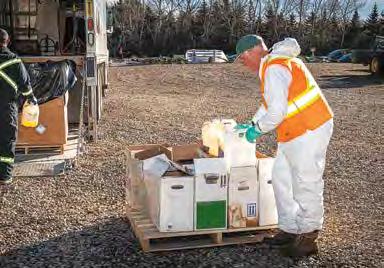



Regions
Peace Region – Alberta & BC
Manitoba
Ontario
Newfoundland When September to November 2025 & Fall 2028
Keep this as a reminder to check Cleanfarms.ca to find the full list of collection events for September to November 2025. Managing these materials by taking them to a Cleanfarms collection event will help you maintain a healthy and safe workplace. For


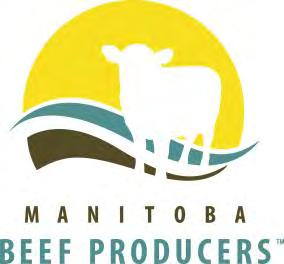
Applications for The Environmental Stewardship Award
Are Due to MBP by December 12, 2025
Manitoba Beef Producers (MBP) is accepting applications until Friday, December 12, 2025 for consideration for the local awarding of The Environmental Stewardship Award (TESA).
Since 1996, TESA has recognized producers who go above and beyond standard industry conservation practices and set positive examples for other cattle producers and the general public. As stewards of a vast portion of the Canadian landscape, Canada’s beef cattle producers play a significant role in protecting and enhancing the environment. They continuously strive to improve existing stewardship conservation practices to create a sustainable future – always farming for tomorrow.
At the local level, a producer receives provincial recognition for their outstanding environmental contributions. In Manitoba, this occurs in conjunction with MBP’s annual general meeting held in February. All provincial award recipients then move forward to compete for national recognition from the Canadian Cattle Association (CCA). The national TESA recipient is announced during the CCA’s semiannual meeting held in late summer or early fall
Each nominee exemplifies significant innovation and attention to a wide range of environmental stewardship aspects in their farm or ranch operation. Such innovations extend beneficially to areas far beyond their land, including water, wildlife and air.
How to Nominate
All beef cattle operations in Canada are eligible to apply for consideration for TESA. Interested producers can either nominate themselves, or be nominated by another individual or an organization. All methods are equally encouraged. More details and the application form can be found at: https://www.cattle.ca/sustainability/tesa
Note: If you are a producer who is considering self-nomination, MBP can provide you with guidance and suggestions on completing the application process.
The completed application form, along with all supporting documentation (such as letters of support, photos and/or videos), is to be submitted to Manitoba Beef Producers by email to info@mbbeef.ca no later than Friday, December 12, 2025. If you have questions, please feel free to contact the MBP office at 204-772-4542.
SCHOLARSHIP APPLICATIONS NOW OPEN FOR THE 2025 CANADIAN BEEF CHECK-OFF AGENCY AWARD
It is no surprise that Canada’s beef industry continues to focus on the engagement of young entrants into the beef industry, whether that be grassroots producers, future leaders of our national and provincial organizations, or industry partners along the value chain.
The Canadian Beef Check-Off Agency (the Agency) continues to diversify its youth strategy with the renewal of the annual scholarship, aimed at students who intend to make an impact in Canada’s beef industry.


The scholarship is open not only to beef producers and those directly involved with their families, but it is open to students who can see unique ways to make an impact through marketing, research, public engagement, and other areas where check-off dollars are invested to generate value for the beef industry in Canada.
“We are working hard to ensure that we are engaging the next generation of industry leaders,” said Trevor Welch, Agency Chair. “This scholarship allows us to reach pockets of young producers that we often find it challenging to connect with.”
Adeleen Bolduc, the Agency’s Youth Member and member of the scholarship committee, sees value in the extensive range of career paths that can help shape Canada’s beef industry.
“Our scholarship outreach is one of the most successful communications programs to date at the Agency ”, said Bolduc. “We have been focusing on different platforms to get the word out to young beef industry stakeholders and it has been extremely positive.”
While preference may be given to applicants who are beef producers or have a background in agriculture, it is not a requirement for the scholarship.
Applicants are asked to submit a 1-2 minute video, showcasing their desire to improve and grow Canada’s beef industry in a unique way. The investment of the beef check-off in Canada delivers value to the beef industry, and the scholarship seeks to support those who want to make an impact in the same way.
The deadline for scholarship applications is June 30, 2025 and the selected applicant will be announced during the Agency’s AGM in August 19, which will be held virtually.
Apply by June 30 at cdnbeefcheckoff.ca/scholarship



Trevor Welch, Agency Chair
Adeleen Bolduc, Agency Youth Member
CANADIAN BEEF CHECK-OFF AGENCY
SCHOLARSHIP
The Canadian Beef Check-Off Agency has established a scholarship to encourage and support students pursuing post-secondary studies in the field of agriculture, agricultural research, or with an agriculture background pursuing studies in marketing or other areas of impact to the beef industry.
ELIGIBILITY CRITERIA
To be eligible for the $2000 scholarship, applicants must:
• be a Canadian citizen or permanent resident
• be accepted to or attending a designated post secondary institution
• be accepted to or attending a full-time program relating to:
• agriculture or agriculture business
• marketing, communications or public relations
• science and research including veterinary medicine
• human health and nutrition
• policy and economics
Note: Preference will be given to applicants who are active beef producers or have a background in agriculture, but it is not a requirement.
HOW TO APPLY
Applicants must submit to the Canadian Beef Check-Off Agency:
• an application form
• a link to a creative video no longer than two minutes, showcasing how their background in agriculture, paired with their education, can help grow the future of the beef industry in Canada
• an official acceptance letter or current enrollment document to a designated post-secondary institution
Videos must be posted to YouTube, marked as public, and the link shared in the application form.
The recipient will be selected by committee on the basis of video content, and desire to improve and grow Canada’s beef industry in a unique way. Knowledge and understanding of Canada’s national beef strategy, checkoff system and national beef organizations is preferred.




